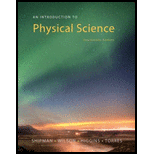
An Introduction to Physical Science
14th Edition
ISBN: 9781305079137
Author: James Shipman, Jerry D. Wilson, Charles A. Higgins, Omar Torres
Publisher: Cengage Learning
expand_more
expand_more
format_list_bulleted
Question
Chapter 20, Problem 6MC
To determine
The cold front advancing under a warm front called.
Expert Solution & Answer
Want to see the full answer?
Check out a sample textbook solution
Students have asked these similar questions
The cylindrical beam of a 12.7-mW laser is 0.920 cm in diameter. What is the rms value of the electric field?
V/m
Consider a rubber rod that has been rubbed with fur to give the rod a net negative charge, and a glass rod that has been rubbed with silk to give it a net positive charge. After being charged by contact by the fur and silk...?
a. Both rods have less mass
b. the rubber rod has more mass and the glass rod has less mass
c. both rods have more mass
d. the masses of both rods are unchanged
e. the rubber rod has less mass and the glass rod has mroe mass
8) 9)
Chapter 20 Solutions
An Introduction to Physical Science
Ch. 20.1 - What are the three essentials of the Bergeron...Ch. 20.1 - Is frost frozen dew?Ch. 20.2 - Prob. 1PQCh. 20.2 - Prob. 2PQCh. 20.3 - Prob. 1PQCh. 20.3 - What is the most violent of storms? Is it the most...Ch. 20.3 - Prob. 20.1CECh. 20.4 - Prob. 1PQCh. 20.4 - Prob. 2PQCh. 20.5 - Prob. 1PQ
Ch. 20.5 - Prob. 2PQCh. 20 - Prob. AMCh. 20 - Prob. BMCh. 20 - Prob. CMCh. 20 - Prob. DMCh. 20 - Prob. EMCh. 20 - Prob. FMCh. 20 - Prob. GMCh. 20 - KEY TERMS 1. coalescence (20.1) 2. Bergeron...Ch. 20 - Prob. IMCh. 20 - Prob. JMCh. 20 - Prob. KMCh. 20 - Prob. LMCh. 20 - Prob. MMCh. 20 - KEY TERMS 1. coalescence (20.1) 2. Bergeron...Ch. 20 - Prob. OMCh. 20 - Prob. PMCh. 20 - Prob. QMCh. 20 - Prob. RMCh. 20 - Prob. SMCh. 20 - Prob. TMCh. 20 - Prob. UMCh. 20 - KEY TERMS 1. coalescence (20.1) 2. Bergeron...Ch. 20 - Prob. WMCh. 20 - Prob. XMCh. 20 - Prob. YMCh. 20 - Prob. 1MCCh. 20 - Which of the following is not essential to the...Ch. 20 - Prob. 3MCCh. 20 - Prob. 4MCCh. 20 - Prob. 5MCCh. 20 - Prob. 6MCCh. 20 - Prob. 7MCCh. 20 - Prob. 8MCCh. 20 - Prob. 9MCCh. 20 - Prob. 10MCCh. 20 - Prob. 11MCCh. 20 - Major concern about global warming arises from...Ch. 20 - Prob. 1FIBCh. 20 - Prob. 2FIBCh. 20 - Prob. 3FIBCh. 20 - Prob. 4FIBCh. 20 - Prob. 5FIBCh. 20 - Prob. 6FIBCh. 20 - Prob. 7FIBCh. 20 - Prob. 8FIBCh. 20 - Prob. 9FIBCh. 20 - Prob. 10FIBCh. 20 - Prob. 11FIBCh. 20 - Prob. 12FIBCh. 20 - Prob. 1SACh. 20 - Prob. 2SACh. 20 - Prob. 3SACh. 20 - Prob. 4SACh. 20 - Prob. 5SACh. 20 - Prob. 6SACh. 20 - (a) Where can lightning take place? (Where can it...Ch. 20 - Prob. 8SACh. 20 - Prob. 9SACh. 20 - Prob. 10SACh. 20 - Prob. 11SACh. 20 - What is the major source of energy for a tropical...Ch. 20 - Prob. 13SACh. 20 - What three months are the peak season in the...Ch. 20 - Prob. 15SACh. 20 - Is air pollution a relatively new problem?...Ch. 20 - Prob. 17SACh. 20 - Prob. 18SACh. 20 - Prob. 19SACh. 20 - Distinguish between classical smog and...Ch. 20 - Prob. 21SACh. 20 - What is the major fossil-fuel impurity?Ch. 20 - Prob. 23SACh. 20 - Prob. 24SACh. 20 - Prob. 25SACh. 20 - Prob. 26SACh. 20 - What is a direct effect on humans that increases...Ch. 20 - Prob. 28SACh. 20 - Visualize the connections and give answers in the...Ch. 20 - Why do household barometers often have descriptive...Ch. 20 - Prob. 2AYKCh. 20 - Prob. 3AYKCh. 20 - Prob. 4AYKCh. 20 - Prob. 1ECh. 20 - What would be the classifications of the air...Ch. 20 - Prob. 3ECh. 20 - Prob. 4ECh. 20 - Prob. 5ECh. 20 - While picnicking on a summer day, you hear thunder...
Knowledge Booster
Similar questions
- Lab 8 Part 3 PHET Wave Interface simulation. I am having trouble with this part of the lab.arrow_forwardMick and Rick are twins born on Earth in the year 2175. Rick grows up to be an Earth-bound robotics technician while Mick becomes an intergalactic astronaut. Mick leaves the Earth on his first space mission in the year 2200 and travels, according to his clock, for 10 years at a speed of 0.75c. Unfortunately, at this point in his journey, the structure of his ship undergoes mechanical breakdown and the ship explodes. How old is Rick when his brother dies?arrow_forwardHi, I have canceled, why did you charge me again?arrow_forward
arrow_back_ios
SEE MORE QUESTIONS
arrow_forward_ios
Recommended textbooks for you
 An Introduction to Physical SciencePhysicsISBN:9781305079137Author:James Shipman, Jerry D. Wilson, Charles A. Higgins, Omar TorresPublisher:Cengage Learning
An Introduction to Physical SciencePhysicsISBN:9781305079137Author:James Shipman, Jerry D. Wilson, Charles A. Higgins, Omar TorresPublisher:Cengage Learning
 AstronomyPhysicsISBN:9781938168284Author:Andrew Fraknoi; David Morrison; Sidney C. WolffPublisher:OpenStax
AstronomyPhysicsISBN:9781938168284Author:Andrew Fraknoi; David Morrison; Sidney C. WolffPublisher:OpenStax Horizons: Exploring the Universe (MindTap Course ...PhysicsISBN:9781305960961Author:Michael A. Seeds, Dana BackmanPublisher:Cengage Learning
Horizons: Exploring the Universe (MindTap Course ...PhysicsISBN:9781305960961Author:Michael A. Seeds, Dana BackmanPublisher:Cengage Learning Foundations of Astronomy (MindTap Course List)PhysicsISBN:9781337399920Author:Michael A. Seeds, Dana BackmanPublisher:Cengage Learning
Foundations of Astronomy (MindTap Course List)PhysicsISBN:9781337399920Author:Michael A. Seeds, Dana BackmanPublisher:Cengage Learning

An Introduction to Physical Science
Physics
ISBN:9781305079137
Author:James Shipman, Jerry D. Wilson, Charles A. Higgins, Omar Torres
Publisher:Cengage Learning


Astronomy
Physics
ISBN:9781938168284
Author:Andrew Fraknoi; David Morrison; Sidney C. Wolff
Publisher:OpenStax

Horizons: Exploring the Universe (MindTap Course ...
Physics
ISBN:9781305960961
Author:Michael A. Seeds, Dana Backman
Publisher:Cengage Learning

Foundations of Astronomy (MindTap Course List)
Physics
ISBN:9781337399920
Author:Michael A. Seeds, Dana Backman
Publisher:Cengage Learning
